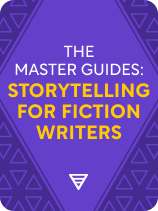

This article is an excerpt from the Shortform book guide to "The Master Guides: Storytelling for Fiction Writers" by Shortform. Shortform has the world's best summaries and analyses of books you should be reading.
Like this article? Sign up for a free trial here.
Is a story outline the right strategy for you? What tactic makes it easier for you to “kill your darlings” when it’s time? What trait might you need to overcome to complete the last step in the writing process?
We’ve drawn on the advice of several storytelling experts to distill the story-writing process into six steps. You’ll get advice on how to find story ideas, get into the right mindset, write a first draft, take a break, revise your story, and share your finished story with others.
Keep reading to learn the steps in writing a story with insights from Stephen King, Elizabeth Gilbert, Robert McKee, and others.
Step #1: Find Story Ideas
The first step in writing a story is to find ideas. Rob Biesenbach recommends noticing the stories that play out in your everyday life. You can also interview people about their stories. Alternatively, plumb your own personal history for stories that relate to the message you want to convey.
Stephen King advises writers to “write what they know.” However, he’s not referring to what you literally know (otherwise nobody could write about going to Mars). Rather, he means you should write about the truths you understand.
In Big Magic, Elizabeth Gilbert (the author of Eat, Pray, Love) asserts that all creative people get their ideas from a mystical or spiritual force of creativity that she calls “Big Magic.” According to Gilbert, Big Magic is always trying to leave clues to help you in your creative pursuit. All you need to do is look out for these clues. Gilbert writes that clues can take the form of coincidences, items of beauty, dreams, feelings of déjà vu, and other strange occurrences that interrupt usual daily life.
Step #2: Cultivate a First-Draft Mindset
The second step in writing a story is to put yourself in the right frame of mind to knock out a first draft. Here are three expert tips on how to cultivate an effective drafting mindset.
Tip #1: Don’t wait for inspiration. According to Seth Godin, creativity is an action, not a feeling. It’s better to create something that’s not great and work to improve it than to say you’re stuck and not create anything at all.
Tip #2: Focus on the journey, not the destination. As you approach a new project, Elizabeth Gilbert stresses that your enjoyment of the creative journey should be your only focus. Let go of any goals or desired outcomes and prioritize the process.
Tip #3: Protect your story from the outside world. When you write your first draft, Stephen King suggests that you close your door. He means this both literally and metaphorically. Literally, close your study or office door to help you focus and block out the outside world. By and large, don’t worry about what anyone else thinks.
Step #3: Write a First Draft
The third step in writing a story is to write a first draft. Stephen King recommends writing your first draft before you know where the story is going. This creates a more truthful story; if you merely observe how characters behave, they’ll be more likely to ring true. This style of writing also maintains suspense. King also recommends you write as quickly as you comfortably can.
Another strategy is to write an outline before you begin the first draft. Robert McKee recommends writers begin with an outline that’s solely an overview of the plot, without dialogue or elaborate scene descriptions. Since you’re essentially writing your entire story in outline form, this step will take up the majority of your time. McKee recommends outlining many more scenes than you end up using.
Step #4: Step Away
After you’ve finished your first draft, some experts recommend taking a break from your writing. Stephen King suggests taking at least six weeks off from your draft and working on shorter pieces like novellas or short stories. During this time, resist the temptation to read your draft. The point is to get distance from it so you can be a more objective critic when you revise. That way, it’ll be easier to “kill your darlings”—cut weak elements of your story that you feel attached to despite their flaws.
You may not need to wait until your first draft is finished to take a break—Elizabeth Gilbert recommends stepping away whenever you find yourself struggling to progress. Find a different creative pursuit to engage with temporarily. By engaging in a creative activity you have no prior investment in, and by having no expectation of quality results, you’re often able to re-access your creative playfulness. That playfulness can then find its way into your original project, unblocking you.
Step #5: Revise Your Story
The fifth step in writing a story is to revise your story. William Zinsser contends that although many writers avoid rewriting, all great writers revise their work—no one writes a masterpiece on the first try. Rewriting is part of the writing process, so don’t skip this crucial step. This process will help you find better, simpler ways of expressing your ideas.
Stephen King asserts that when you revise, you need to “open your door.” Think about your audience and how to make at least some of them happy. Take in feedback from people you trust and work to reconcile their feedback with your vision.
As you revise, King suggests you ask yourself big-picture questions: What’s the story about? Is there a theme? Are there recurring elements? Is the story coherent? Polish these big-picture ideas as well as fixing the small, specific issues. Once you define your theme, add scenes and shape the story to strengthen the theme.
Step #6: Share Your Finished Story
Finally, you have to declare your story finished and share it with others. Some experts contend this step is more difficult than it appears. To finish and share your work, you must overcome perfectionism—which is, according to Elizabeth Gilbert, one of the greatest mental obstacles to creativity. She believes that, no matter how hard you try, you’ll never be able to attain perfection; there’ll always be a way someone can find your work lacking. It’s therefore pointless to strive for perfection and better just to create something imperfect and put it into the world.
To curb perfectionism, take pride in the completion of a project rather than in the attainment of an ideal, recommends Gilbert. Many creators don’t complete projects, so finishing is an achievement in itself.
Seth Godin takes this idea further, asserting that sharing “bad” work or ideas is essential to creating good work. Sharing work that’s not good shows you that you can survive it and learn from it. To this end, he recommends promising to deliver your work on a schedule, no matter how each project turns out.
Shortform Resources
For more practical tips that will help you write stories, see the following Shortform guides:
- Unleash the Power of Storytelling, Rob Biesenbach
- On Writing, Stephen King
- Wired for Story, Lisa Cron
- On Writing Well, William Zinsser
For more information on the theory behind storytelling, see the following book guides:
- Story, Robert McKee
- How to Read Literature Like a Professor, Thomas C. Foster
- The Hero With a Thousand Faces, Joseph Campbell
For more general advice on how to live a productive, creative life, see the following book guides:
- The Practice, Seth Godin
- Big Magic, Elizabeth Gilbert

———End of Preview———
Like what you just read? Read the rest of the world's best book summary and analysis of Shortform's "The Master Guides: Storytelling for Fiction Writers" at Shortform.
Here's what you'll find in our full The Master Guides: Storytelling for Fiction Writers summary:
- How to capture and communicate emotional magic through fiction
- Advice from successful authors and storytelling experts
- The five steps of writing a story, from ideating to publishing






